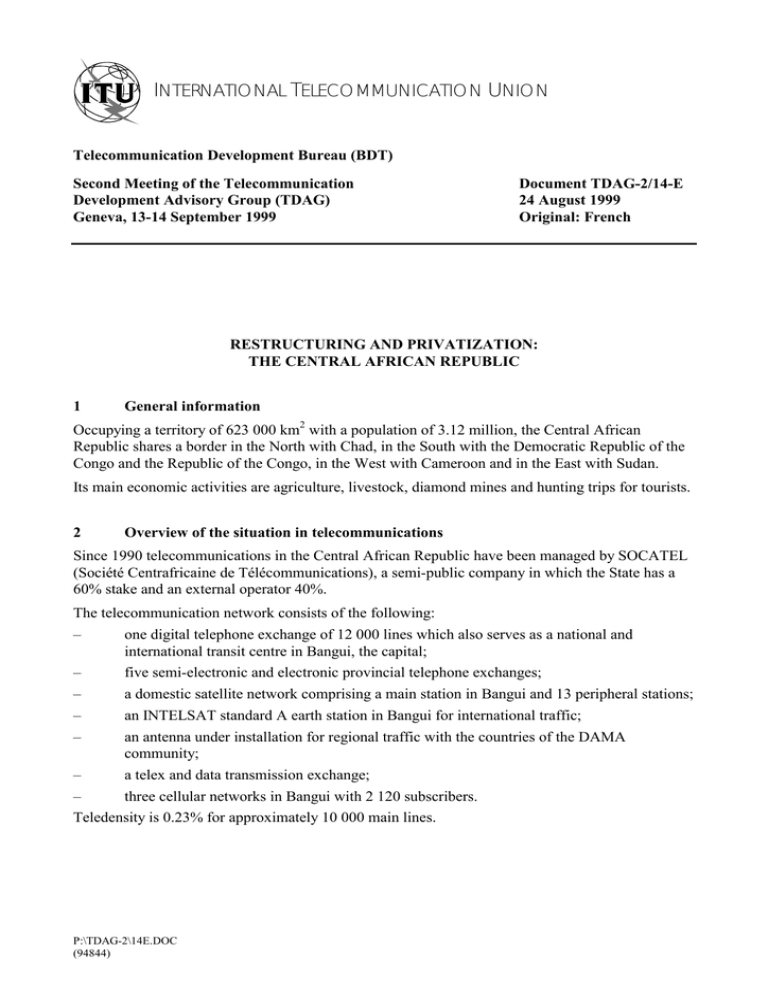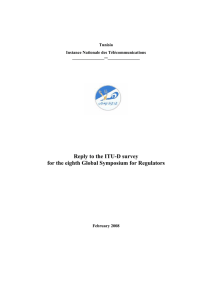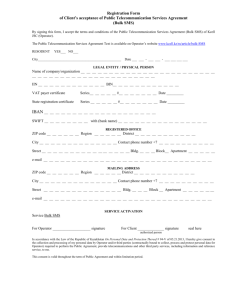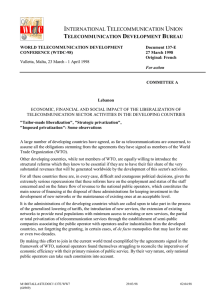I T U
advertisement

INTERNATIONAL TELECOMMUNICATION UNION Telecommunication Development Bureau (BDT) Second Meeting of the Telecommunication Development Advisory Group (TDAG) Geneva, 13-14 September 1999 Document TDAG-2/14-E 24 August 1999 Original: French RESTRUCTURING AND PRIVATIZATION: THE CENTRAL AFRICAN REPUBLIC 1 General information Occupying a territory of 623 000 km2 with a population of 3.12 million, the Central African Republic shares a border in the North with Chad, in the South with the Democratic Republic of the Congo and the Republic of the Congo, in the West with Cameroon and in the East with Sudan. Its main economic activities are agriculture, livestock, diamond mines and hunting trips for tourists. 2 Overview of the situation in telecommunications Since 1990 telecommunications in the Central African Republic have been managed by SOCATEL (Société Centrafricaine de Télécommunications), a semi-public company in which the State has a 60% stake and an external operator 40%. The telecommunication network consists of the following: – one digital telephone exchange of 12 000 lines which also serves as a national and international transit centre in Bangui, the capital; – five semi-electronic and electronic provincial telephone exchanges; – a domestic satellite network comprising a main station in Bangui and 13 peripheral stations; – an INTELSAT standard A earth station in Bangui for international traffic; – an antenna under installation for regional traffic with the countries of the DAMA community; – a telex and data transmission exchange; – three cellular networks in Bangui with 2 120 subscribers. Teledensity is 0.23% for approximately 10 000 main lines. P:\TDAG-2\14E.DOC (94844) -2TDAG-2/14-E 3 Restructuring of the sector and privatization In the context of its policy to open up the economy, the Government decided in 1996 to continue with the restructuring of the telecommunication sector embarked on in 1990. Hence the following legislative measures were adopted to encourage the private sector to invest in telecommunications: – partial liberalization of the sector; – separation of the regulatory and operating functions; – definition of the roles of public and private operators; – withdrawal of the State from incumbent operator management functions by transfer of some of its shares. 3.1 Liberalization of the sector According to the law, only the basic service (telephony between two fixed points and telex) is set aside for the public operator, while mobile telephony and value-added services are opened up to competition. It should be pointed out, however, that provision of the basic network may be entrusted to a private operator in areas where the public operator is not in a position to invest. Accordingly, private telecentres may be set up in order to provide various services. 3.2 Role of the regulatory body ART, the regulatory body, is under the authority of the ministry responsible for telecommunications but it has financial autonomy. Its main tasks are to: – apply the regulations in the field of telecommunications; – manage and monitor the use of the radio-frequency spectrum; – issue licences and authorizations for the use of telecommunication services; – lay down technical specifications and tariff rules; – ensure universality and quality of telecommunication services. 3.3 Roles of the operators The public operator is responsible for providing basic infrastructure throughout the national territory. Its activities are defined in an outline contract signed with the State. Private operators provide value-added services and mobile telephony. Currently three private operators are running cellular networks. 4 Conclusion Since the partial liberalization, private operators have been attracted and applications for licences have been pouring in. Four operators, including three private ones, are already operating on a cellular market estimated to comprise 13 000 subscribers by 2000. P:\TDAG-2\14E.DOC (94844) -3TDAG-2/14-E This raises the problem of the size of the market in a liberalized sector. Other problems limiting involvement from the private sector are: – the security situation; – the political situation; – the lack of national savings; – the difficulty of concluding a partnership with a foreign operator. Nevertheless, the State intends to pursue its negotiations for its withdrawal from incumbent operator management functions and to convene a round table with the public and private sector and international partners for the financing of an incumbent operator investment programme. ______________ P:\TDAG-2\14E.DOC (94844)







